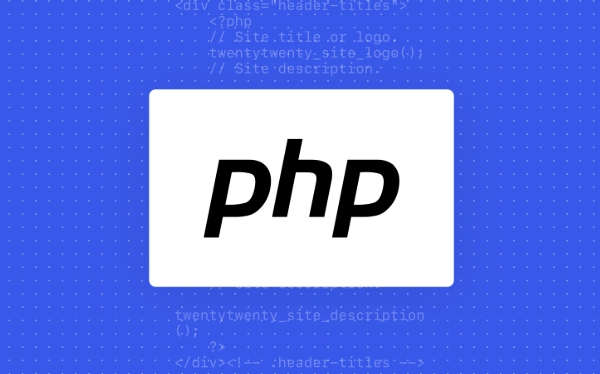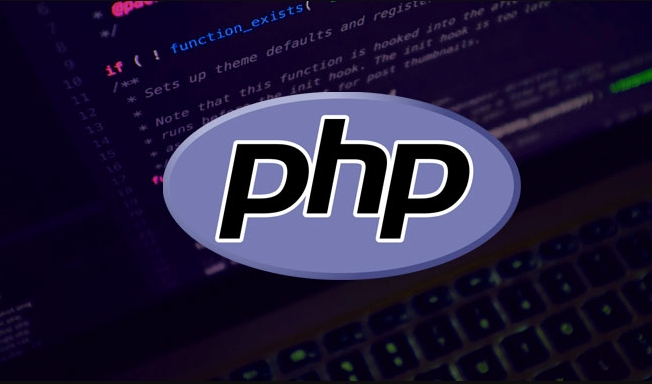Regular expressions for verifying email address can be implemented through regex in PHP. The common writing method is: ^[a-zA-Z0-9.\_% -] @[a-zA-Z0-9.-] \.[a-zA-Z]{2,}$. 1. The user name part allows letters, numbers and partial symbols, such as dots, underscores, percent signs, etc., to represent at least one character; 2. The domain name part consists of letters, numbers, dots and minus signs, and the top-level domain name requires more than two letters; 3. This rule is suitable for most actual scenarios, but does not fully comply with the RFC standard; 4. It is recommended to use the PHP built-in function filter_var() for verification first; 5. When using the rule, you can consider adding modifiers i and u to improve compatibility.

Regular expressions for verifying email addresses are a common requirement in PHP. Although PHP has a built-in function filter_var() that can be used directly to verify mailboxes, sometimes you may need more flexible control, and you need to use regular expressions (regex).

The following regular expression is a relatively general way to write it in terms of practicality and compatibility:

$email = "example@test.com";
if (preg_match("/^[a-zA-Z0-9._% -] @[a-zA-Z0-9.-] \.[a-zA-Z]{2,}$/", $email)) {
echo "valid mailbox";
} else {
echo "Invalid mailbox";
}The structure of this regular expression can be broken down into several parts to understand.
Email username part: [a-zA-Z0-9._% -]
The @ of the mailbox is preceded by the username part, which usually allows the following characters:

- Letters az and AZ
- Numbers 0-9
- dot number
., underline__percent sign%, plus sign-
Note that this is used here Indicates that there is at least one character.
Common legal user names such as:
- john.doe
- user 123
- test%email
So this part of regular writing: [a-zA-Z0-9._% -]
Email domain name part: [a-zA-Z0-9.-] \.[a-zA-Z]{2,}
@The following part is domain names and top-level domain names, such as gmail.com or mail.co.uk
- The domain name body consists of letters, numbers, dots and minus signs:
[a-zA-Z0-9.-] - Then there is a dot number
\.(Please escape) - Finally, there are top-level domains, usually two or more letters:
[a-zA-Z]{2,}
For example:
- example.com ?
- sub.mail.co.uk ?
- exa_mple.com ? (Domain name does not allow underscore)
Some things to note
- This regularity is loose and will not cover all legal mailbox formats defined by RFC standards, but can meet most practical usage scenarios.
- If you pursue extreme standard compatibility, the rules will become very complex, even hundreds of characters, but they are not recommended in daily development.
- Users are not advised to build their own wheels unless there are special needs. PHP's
filter_var($email, FILTER_VALIDATE_EMAIL)is a safer choice.
Tips: Common modifiers for PHP regular
If you have problems using regulars, check if the modifier is missing:
-
i: case insensitive (optional) -
u: Process UTF-8 encoding (if international mailbox is supported, you can add it)
For example:
"/^[a-zA-Z0-9._% -] @[a-zA-Z0-9.-] \.[a-zA-Z]{2,}$/iu"Basically that's it. If you use this rule well, you can complete the basic verification of the email format in most cases.
The above is the detailed content of php regex for email validation. For more information, please follow other related articles on the PHP Chinese website!

Hot AI Tools

Undress AI Tool
Undress images for free

Undresser.AI Undress
AI-powered app for creating realistic nude photos

AI Clothes Remover
Online AI tool for removing clothes from photos.

Clothoff.io
AI clothes remover

Video Face Swap
Swap faces in any video effortlessly with our completely free AI face swap tool!

Hot Article

Hot Tools

Notepad++7.3.1
Easy-to-use and free code editor

SublimeText3 Chinese version
Chinese version, very easy to use

Zend Studio 13.0.1
Powerful PHP integrated development environment

Dreamweaver CS6
Visual web development tools

SublimeText3 Mac version
God-level code editing software (SublimeText3)

Hot Topics
 What are some best practices for versioning a PHP-based API?
Jun 14, 2025 am 12:27 AM
What are some best practices for versioning a PHP-based API?
Jun 14, 2025 am 12:27 AM
ToversionaPHP-basedAPIeffectively,useURL-basedversioningforclarityandeaseofrouting,separateversionedcodetoavoidconflicts,deprecateoldversionswithclearcommunication,andconsidercustomheadersonlywhennecessary.StartbyplacingtheversionintheURL(e.g.,/api/v
 How do I implement authentication and authorization in PHP?
Jun 20, 2025 am 01:03 AM
How do I implement authentication and authorization in PHP?
Jun 20, 2025 am 01:03 AM
TosecurelyhandleauthenticationandauthorizationinPHP,followthesesteps:1.Alwayshashpasswordswithpassword_hash()andverifyusingpassword_verify(),usepreparedstatementstopreventSQLinjection,andstoreuserdatain$_SESSIONafterlogin.2.Implementrole-basedaccessc
 What are the differences between procedural and object-oriented programming paradigms in PHP?
Jun 14, 2025 am 12:25 AM
What are the differences between procedural and object-oriented programming paradigms in PHP?
Jun 14, 2025 am 12:25 AM
Proceduralandobject-orientedprogramming(OOP)inPHPdiffersignificantlyinstructure,reusability,anddatahandling.1.Proceduralprogrammingusesfunctionsorganizedsequentially,suitableforsmallscripts.2.OOPorganizescodeintoclassesandobjects,modelingreal-worlden
 What are weak references (WeakMap) in PHP, and when might they be useful?
Jun 14, 2025 am 12:25 AM
What are weak references (WeakMap) in PHP, and when might they be useful?
Jun 14, 2025 am 12:25 AM
PHPdoesnothaveabuilt-inWeakMapbutoffersWeakReferenceforsimilarfunctionality.1.WeakReferenceallowsholdingreferenceswithoutpreventinggarbagecollection.2.Itisusefulforcaching,eventlisteners,andmetadatawithoutaffectingobjectlifecycles.3.YoucansimulateaWe
 How can you handle file uploads securely in PHP?
Jun 19, 2025 am 01:05 AM
How can you handle file uploads securely in PHP?
Jun 19, 2025 am 01:05 AM
To safely handle file uploads in PHP, the core is to verify file types, rename files, and restrict permissions. 1. Use finfo_file() to check the real MIME type, and only specific types such as image/jpeg are allowed; 2. Use uniqid() to generate random file names and store them in non-Web root directory; 3. Limit file size through php.ini and HTML forms, and set directory permissions to 0755; 4. Use ClamAV to scan malware to enhance security. These steps effectively prevent security vulnerabilities and ensure that the file upload process is safe and reliable.
 How can you interact with NoSQL databases (e.g., MongoDB, Redis) from PHP?
Jun 19, 2025 am 01:07 AM
How can you interact with NoSQL databases (e.g., MongoDB, Redis) from PHP?
Jun 19, 2025 am 01:07 AM
Yes, PHP can interact with NoSQL databases like MongoDB and Redis through specific extensions or libraries. First, use the MongoDBPHP driver (installed through PECL or Composer) to create client instances and operate databases and collections, supporting insertion, query, aggregation and other operations; second, use the Predis library or phpredis extension to connect to Redis, perform key-value settings and acquisitions, and recommend phpredis for high-performance scenarios, while Predis is convenient for rapid deployment; both are suitable for production environments and are well-documented.
 What are the differences between == (loose comparison) and === (strict comparison) in PHP?
Jun 19, 2025 am 01:07 AM
What are the differences between == (loose comparison) and === (strict comparison) in PHP?
Jun 19, 2025 am 01:07 AM
In PHP, the main difference between == and == is the strictness of type checking. ==Type conversion will be performed before comparison, for example, 5=="5" returns true, and ===Request that the value and type are the same before true will be returned, for example, 5==="5" returns false. In usage scenarios, === is more secure and should be used first, and == is only used when type conversion is required.
 How do I perform arithmetic operations in PHP ( , -, *, /, %)?
Jun 19, 2025 pm 05:13 PM
How do I perform arithmetic operations in PHP ( , -, *, /, %)?
Jun 19, 2025 pm 05:13 PM
The methods of using basic mathematical operations in PHP are as follows: 1. Addition signs support integers and floating-point numbers, and can also be used for variables. String numbers will be automatically converted but not recommended to dependencies; 2. Subtraction signs use - signs, variables are the same, and type conversion is also applicable; 3. Multiplication signs use * signs, which are suitable for numbers and similar strings; 4. Division uses / signs, which need to avoid dividing by zero, and note that the result may be floating-point numbers; 5. Taking the modulus signs can be used to judge odd and even numbers, and when processing negative numbers, the remainder signs are consistent with the dividend. The key to using these operators correctly is to ensure that the data types are clear and the boundary situation is handled well.






